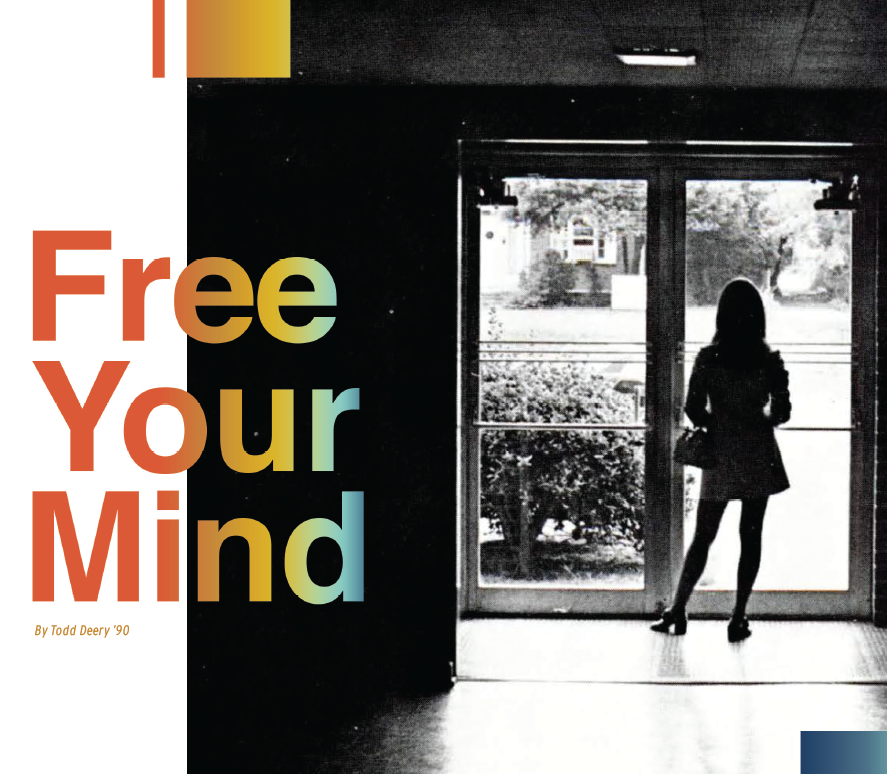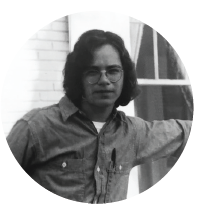A mix of educational innovation and counterculture zeal, Auburn’s Free University Movement empowered students and infuriated administrators.
By Todd Deery ’90

Talking with Miriam Saxon ’72 is as pleasant an experience as you’ll have. She is soft spoken and thoughtful and measures her words when she speaks. It’s disarming when she says, “In a few minutes’ time, I have to go take our rooster… we got busted for having a rooster in town, so I have found a new home for him. Yeah, we had somebody rat us out.”
You see, Miriam Saxon is many things. An Auburn native. Daughter of two Auburn faculty members. An Auburn alumna. An Episcopal priest. And a bit of an undercover radical, even in her pet choices.
Fifty years ago, Saxon (then Miriam Scarsbrook), along with friend Marion Cox ’71, led one of the most experimental and fun educational movements in Auburn’s history: the Extra-Curricular Studies Program (ESP).
On its face, ESP was simply an attempt to offer free classes to students on topics the faculty were unable or reluctant to cover. With no tuition, no grades and no set meeting place, the classes quickly became boom-or-bust litmus tests for the interests of the student body, many of whom loved Auburn but were dissatisfied with its conservative nature and resistance to change.
“I think it was just starting it to do something fun and a little bit off the track for the rest of the university. I think Marion and I and John (Saxon, now Miriam’s husband) and some others were looking for something that wasn’t just the standard state university stuff, maybe in a tiny bit of poking-a-finger-in-an-eye way, to be honest. Just a little bit,” Saxon said.
Free The University
Winter quarter of 1969, a group of Auburn students launched a “Free University” program, announcing in the “Deserted Village” underground newspaper that Auburn students today were “less frivolous, better informed and chronologically older” than their counterparts from 50 or 60 years ago. The movement offered a range of supplementary courses in religion, law and even “Sgt. Pepper & other Bands.” The movement’s reasoning was made clear in the preamble to their announcement.
“Undergraduates across the country are seeking to realize their dreams of what education ought to be: not only should teachers be free to teach what they want, but students should also be free to learn what they want.”
At the start, the Free University Program was not funded by the university, and Jean Ford ’69, a student organizer at the time, made clear that the program should not concern administrators.
“We are stressing that this program will be optional and is in no way an attempt to overthrow the university,” Ford said in the Auburn Plainsman.
“Undergraduates across the country are seeking to realize their dreams of what education ought to be: not only should teachers be free to teach what they want, but students should also be free to learn what they want.”
Early returns looked promising as more than 400 students met in classrooms, restaurants and bars to discuss topics such as “Field Work Archaeology,” “Kite Flying” and “Problems of Communism in Asia.”
By late 1969, SGA was providing some funds for the Free University (causing the Plainsman to run several editorials bemoaning its lack of autonomy), and the program suffered from waning interest because of its idealistic courses and difficulty finding meeting spaces. The program changed the courses to shorter seminars and installed more practical classes, but without consistent student support, the one-year experiment ended.
Enter Saxon and Cox.
In late 1971, the Kappa Delta sorority sisters bonded over their love of Auburn and willingness to shake things up a bit. Looking around at schools like UNC Chapel Hill and University of California, Berkeley, they decided to create a better version of the Free University that had failed at Auburn before. That included coming up with a title whose acronym would double for extrasensory perception. “We thought we were so clever,” Saxon says with an eye roll.
“She was a little bit different than the norm; she had more of a progressive outlook on the world. I was beginning to develop a more progressive outlook, and we became fast friends,” Cox said of Saxon.
ESP’s mix of student empowerment, ’60s cultural idealism and innovative educational thinking was evident right from the start. The forward to their spring 1972 brochure questioned many educational assumptions in a direct appeal to students.
“Ask yourself why you are caught up in a maze of university red tape, boring classes, staying up all night to get a degree. In a university concentrating on highly specialized skills, ESP is an attempt to relieve the monotony of the classroom, to stimulate students to widen their scope, to motivate students to think and explore, to provide students with a creative outlet for their expressions, and to create an experiment in education at Auburn.”

Miriam Saxon around 1972
“Ask yourself why you are caught up in a maze of university red tape, boring classes, staying up all night to get a degree.”
ESP’s inaugural six offerings in January 1972 were a mix of the practical and idealistic. Courses on photography, macrame and first aid were offered alongside “Women’s Lib,” “Radical Educational Change” and “Encounter Marathon.” Sixteen courses were offered in the spring quarter, with an increased emphasis on hands-on learning and more faculty involvement. But the relaxed atmosphere, no cost and no grades remained.
But after two quarters where almost 500 people participated, getting continued support proved difficult. Poorly attended courses were dropped, and Cox and Saxon worked tirelessly to get the word out and keep the students and teachers (some of whom were Auburn faculty, students
and members of the community) engaged and committed.
Speaking Of Controversy
ESP’s influence extended beyond the classes. A series of invited speakers roiled campus in 1971-72. National luminaries like feminist Gloria Steinem and consumer protection advocate Ralph Nader were among those who spoke to packed houses on the Plains.
This was on the heels of Yale chaplain and anti-war speaker William Sloane Coffin’s controversial appearance in February 1969. Auburn President Harry M. Philpott vetoed funds that had been set aside for him to appear. A lawsuit was filed and a ruling against the university was made by judge Frank M. Johnson in Montgomery. The lawsuit, and Coffin’s appearance, caused an uproar for a year over censorship and the university’s role in bringing new ideas to campus.
Nader, author of the 1965 book “Unsafe At Any Speed,” exposed the automobile industry’s safety issues (particularly in the Chevrolet Corvair), and had become a force in the growing consumer rights area. Cox and a group of students picked up the perennially disheveled Nader at the Columbus, Ga. Airport—in a Chevy Corvair.
“We promised that he wasn’t going to die in the car before we could get into Auburn. He was a good sport about it, but boy, that really threw him for a loop,” Cox said, laughing as she recalled the incident.
Unlike the previous Free University, ESP had quickly become part of the SGA infrastructure.

In ESP’s free auto mechanics course, you could learn how a motor works.
In a glowing feature in the Plainsman in February 1972, SGA president Jimmy Tucker cited it as one of his administration’s best achievements. After all, it was about improving access to ideas and education, something that aligned with Auburn’s land-grant mission.
And then the “General Bullshit” controversy hit. Saxon had sent their spring of 1972 class schedule to be printed at University Duplicating Services. A worker had balked at the title of one of the classes and notified J.H. White, director of university relations. Called into White’s office, Saxon explained that the class would feature Frisbee throwing and creek banking and would discuss other ways to have fun. White told her the word would offend students and alumni. Saxon asked where in university policy that word was forbidden. White couldn’t directly cite any source.
“We thought it was, again, a funny title, that it would catch a lot of students’ attention, never thinking we’d catch unwanted attention. I remember being really surprised that they wouldn’t publish it,” Saxon said. She eventually changed the word to “Bulls&^%” and got it published.
Both Cox and Saxon recall getting called into administrators’ offices several times, a by-product of their participation in the culture wars. Cox recalls the feeling after getting called into Dean of Women Katherine Cooper Cater’s office in 1972, after Gloria Steinem visited campus and critiqued many of the rules governing women students on campus.
“I think when we walked into the office, probably our knees were trembling a little bit. When we left the office, we were probably doing high fives because, I mean, we didn’t break any rules. We thought we had pulled off the coup of the century,” Cox said.
“I think that college has always been a time when folks are trying to figure out who they are and where they are in the world. That’s always been true. I think it was especially true in the late ’60s and early ’70s,” John Saxon ’72, Miriam’s husband added.
Final Exam
Like its predecessor, ESP eventually burned out. In fall 1972 it was renamed the Free University Program, with the old name labeled confusing and worn out by new leadership. What is old is new again.
Saxon and Cox had graduated. The program was gone by the following fall. But the significance of those classes and the movement is all too obvious today. Things like the massive open online course (MOOCs) movement which provides free classes online, is animated by the same impulses that Cox and Saxon made real in Haley Center more than 50 years ago. Even Auburn’s own Osher Lifelong Learning Institute (one of 122 nationwide) provides alternative courses outside the norms of traditional classrooms.
While Miriam Saxon and Marion Cox both know that ESP, the black armbands on campus and the fiery speakers all challenged the mainstream at the time, they did so out of a love of Auburn and a feeling that it could be better. That it had to be better.
For Cox, the radical ecology class offered by ESP was the beginning of her love of the environment, something she has spent 40 years protecting as an environmental planner, consultant and mediator. For John and Miriam, now both clergy, their time at Auburn provided opportunities for them to stand up for what they believe is right, something that has continued throughout their lives.
“We all loved Auburn. We loved the community. We loved the people,” Cox said. “We loved the institution, but it wasn’t serving everything we were at that university to get out of it. We decided to do something about it. It was exciting to us. We thought it was important.”

John Saxon circa 1972
“I think that college has always been a time when folks are trying to figure out who they are and where they are in the world. That’s always been true.”
An Eye for Action
From the mound to the mountain, Blake Gordon ’03 has captured life on the edge.
Charting Her Course
From Auburn’s campus to the world’s most advanced warships, Emily Curran ’10 has never forgotten where she found her footing.
Building a Brand, Cultivating a Community
A fashion emergency and a social media surge helped Kayla Jones ’18 launch her brand Women With Ballz.
An Eye for Action
From the mound to the mountain, Blake Gordon ’03 has captured life on the edge.
Charting Her Course
From Auburn’s campus to the world’s most advanced warships, Emily Curran ’10 has never forgotten where she found her footing.
Building a Brand, Cultivating a Community
A fashion emergency and a social media surge helped Kayla Jones ’18 launch her brand Women With Ballz.


